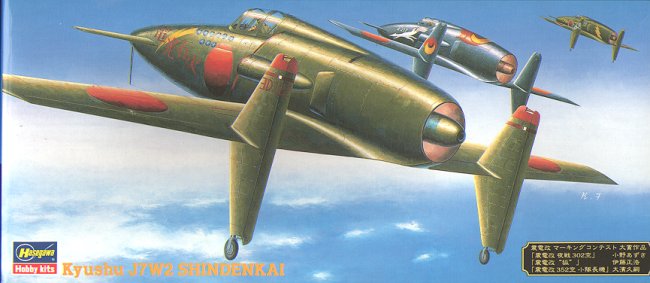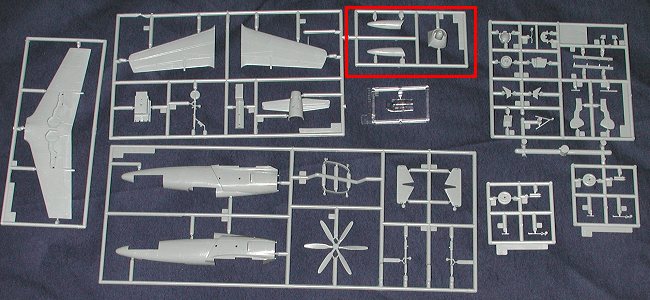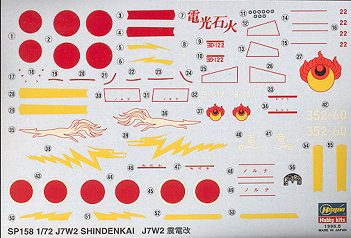
|
KIT: |
Hasegawa 1/72 J7W2 Shinden-Kai |
|
KIT # |
51658 |
|
PRICE: |
$15.98 |
|
DECALS: |
three aircraft |
|
REVIEW & |
|
|
NOTES: |
I'd mark this down as IJNAF '46 ! |

|
HISTORY |
Typical of aircraft designed towards the end of WWII, this particular one never got beyond the planning stage. In fact, the aircraft it is based upon, the J7W1 Shinden, only made three flights before war's end. The J7W1 was designed to be a high performance interceptor, whose goal was to be able to quickly rise to meet attacking bombers and to have sufficiently heavy armament to bring them down.
Initial testing was done using MXY6 gliders to see if the unusual canard configuration was workable. One of these gliders was later powered by a small engine and proved the feasibility of the design. Work was then started on the prototype in June 1944. and completed in ten months, a very quick pace for any new aircraft. Armament was to be 4 30mm cannon, more than enough for the job. A supercharged 2,130 hp Mitsubishi MK9D 18 cylinder radial pushing a six bladed propeller was installed in the aircraft. Despite not having flown, the type was ordered into production, however the end of the war prevented that from reaching fruition.
The three flights made in August of 1945 showed a strong torque pull during takeoff and a great deal of vibration in the prop due to the required extension shaft. A second prototype was built, but not flown. This aircraft was taken to the US and I believe is part of the NASM collection in Washington DC.
The J7W2 Shinden-kai was to be a jet powered version of the J7W1. The radial engine was to be replaced by a 2,000 lb thrust Ne-130 turbojet. The type was never constructed but would have been a logical progression. A similar conversion from piston to jet aircraft was done in Sweden when the Saab J-21 piston engined fighter was adapted to a jet engine and produced as the J-21R.
|
THE KIT |

In the late 1980s, Hasegawa decided to start production of a large number of 1/72 WWII subjects. Most of them are Japanese as the majority of Hasegawa's production is bought at home. They started by new tool Zeros and then really got underway by producing a huge number of kits, all of which could be done in different variants to allow maximum usage of tooling.
In the mid-1990s they did the J7W1 Shinden. Previous to this the aircraft had only been kitted in 1/72 by Tamiya, and it was a very old model first released in the late 1960s. Hasegawa surprised many of us by producing a new tool kit of this one-off prototype. However, they also did several 'what if' decal change boxings and this J7W2 jet powered version.
The kit itself is just what one expects from Hasegawa. Good engineering, fine panel lines, and adequate cockpit and wheel well detailing. Some of the smaller parts and the insides of gear doors and such have ejector pin marks on them. Some will be difficult to remove. The canopy is one piece and cannot be posed open unless you cut it. There are no other options. There is a single small sprue for the 'jet powered' bits which contains larger side intakes and the jet exhaust (in red box above).
 The instructions
are typical Hasegawa as well in that they are superb, giving all the information
that the builder needs regarding painting and any needed modifications. The
decals are quite colorful and offer three fictitious options. Two of the
aircraft are in standard colors for the time with a third in overall black (a
night fighter, I would guess). Hasegawa decals have a history of not being compatible
with setting solutions, but they are all you have to use unless you want to use
your own from a spares box.
The instructions
are typical Hasegawa as well in that they are superb, giving all the information
that the builder needs regarding painting and any needed modifications. The
decals are quite colorful and offer three fictitious options. Two of the
aircraft are in standard colors for the time with a third in overall black (a
night fighter, I would guess). Hasegawa decals have a history of not being compatible
with setting solutions, but they are all you have to use unless you want to use
your own from a spares box.
This kit really looks very nice and is one that I think most builders will enjoy, despite being a 'paper project'. Luft '46 has a rather large following and no reason why the Japanese should not be included in this list!
|
REFERENCES |
Japanese Aircraft of the Pacific War by Rene J. Francillon, 1979
Review kit courtesy of me and my wallet!
If you would like your product reviewed fairly and quickly by a site that has over 1,500 visits a day, please contact me or see other details in the Note to Contributors.